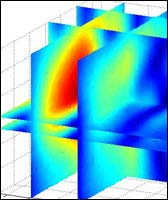Radio waves help see moisture inside walls

Three-dimensional perspective view of a mocked-up wall section. Red circular area at left indicates moisture inside a wall
The building community soon may have radio vision—a new way to “see” moisture inside walls. Building researchers at the National Institute of Standards and Technology (NIST) have joined forces with Intelligent Automation Inc. in Rockville, Md., to develop a way to use ultra wide-band radio waves to non-destructively detect moisture within the walls of a building. As any homeowner who’s suffered with leaky plumbing or mold problems will tell you, the current state of the art for pinpointing moisture problem areas relies mostly on guesswork and a drywall saw.
Based on hardware developed by Intelligent Automation, the new NIST technique involves sending a broad range of radio frequencies through typical drywall construction to look for a “moisture” signature in the signal that is reflected back. Laboratory experiments conducted with a simplified wall section made of gypsum board, fiberglass insulation, and oriented strand board (similar to plywood), demonstrated that the new method can locate moisture pockets to within one centimeter.
The presence of water within the model wall produced a stronger reflection of radio waves at specific frequencies. The elapsed time between transmission of the waves and their arrival at a receiving antenna helps determine the location of the water. By processing the reflected signals with computer software, the researchers can create detailed three-dimensional maps that highlight wet areas.
Research is continuing to see how well the apparatus performs with real walls that include studs, wires, pipes and windows that may complicate the readings. A paper describing the research has been accepted for publication in an upcoming issue of ASHRAE Transactions.
Media Contact
More Information:
http://www.nist.gov/All latest news from the category: Process Engineering
This special field revolves around processes for modifying material properties (milling, cooling), composition (filtration, distillation) and type (oxidation, hydration).
Valuable information is available on a broad range of technologies including material separation, laser processes, measuring techniques and robot engineering in addition to testing methods and coating and materials analysis processes.
Newest articles

A universal framework for spatial biology
SpatialData is a freely accessible tool to unify and integrate data from different omics technologies accounting for spatial information, which can provide holistic insights into health and disease. Biological processes…

How complex biological processes arise
A $20 million grant from the U.S. National Science Foundation (NSF) will support the establishment and operation of the National Synthesis Center for Emergence in the Molecular and Cellular Sciences (NCEMS) at…

Airborne single-photon lidar system achieves high-resolution 3D imaging
Compact, low-power system opens doors for photon-efficient drone and satellite-based environmental monitoring and mapping. Researchers have developed a compact and lightweight single-photon airborne lidar system that can acquire high-resolution 3D…





















